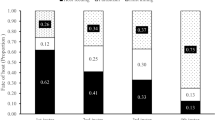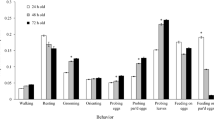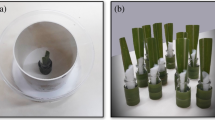Abstract
The native parasitoids Necremnus tutae Ribes & Bernardo and N. cosmopterix Ribes & Bernardo (Hymenoptera: Eulophidae) are potential biocontrol agents of the exotic tomato pest Tuta absoluta (Meyrick) (Lepidoptera: Gelechiidae) in Europe. We investigated the functional response of parasitoid females to different densities of 3rd-instar host larvae (from 3 to 40 hosts offered), as well as some life history traits (longevity, lifetime fecundity, parasitism and host-feeding rate) of N. tutae and N. cosmopterix. In functional response experiments, the rate of attack of both parasitoids was positively correlated with host density, N. tutae and N. cosmopterix showing type III and type II functional response, respectively; the latter species exhibited a higher maximum estimated host-killing rate than the former. Both parasitoids showed high fecundity (> 50 eggs) during their lifetime. The potential application of N. tutae and N. cosmopterix in conservation biological control of T. absoluta is discussed.



Similar content being viewed by others
References
Balzan MV, Wäckers FL (2013) Flowers to selectively enhance the fitness of a host-feeding parasitoid: adult feeding by Tuta absoluta and its parasitoid Necremnus artynes. Biol Control 67:21–31
Balzan MV, Bocci G, Moonen A-C (2016) Landscape complexity and field margin vegetation diversity enhance natural enemies and reduce herbivory by Lepidoptera pests on tomato crop. BioControl 61:141–154
Berthon K (2015) How do native species respond to invaders? Mechanistic and trait-based perspectives. Biol Invasions 17:2199–2211
Bianchi FJJA, Booij CJH, Tscharntke T (2006) Sustainable pest regulation in agricultural landscapes: a review on landscape composition, biodiversity and natural pest control. Proc Biol Sci 273:1715–1727
Biondi A, Zappalà L, Mauro AD et al (2016) Can alternative host plant and prey affect phytophagy and biological control by the zoophytophagous mirid Nesidiocoris tenuis? BioControl 61:79–90
Biondi A, Guedes RNC, Wan F-H, Desneux N (2018) Ecology, worldwide spread, and management of the invasive south american tomato pinworm, Tuta absoluta: past, present, and future. Annu Rev Entomol 63:239–258
Bodino N, Ferracini C, Tavella L (2016) Is host selection influenced by natal and adult experience in the parasitoid Necremnus tutae (Hymenoptera: Eulophidae)? Anim Behav 112:221–228
Bolker BM (2008) Ecological models and data in R. Princeton University Press, Princeton
Calvo FJ, Soriano JD, Bolckmans K, Belda JE (2013) Host instar suitability and life-history parameters under different temperature regimes of Necremnus artynes on Tuta absoluta. Biocontrol Sci Technol 23:803–815
Calvo FJ, Soriano JD, Stansly PA, Belda JE (2016) Can the parasitoid Necremnus tutae (Hymenoptera: Eulophidae) improve existing biological control of the tomato leafminer Tuta absoluta (Lepidoptera: Gelechiidae)? Bull Entomol Res 106(4):502–511
Cameron EK, Vilà M, Cabeza M (2016) Global meta-analysis of the impacts of terrestrial invertebrate invaders on species, communities and ecosystems. Glob Ecol Biogeogr 25:596–606
Campos MR, Biondi A, Adiga A et al (2017) From the Western Palaearctic region to beyond: Tuta absoluta 10 years after invading Europe. J Pest Sci 90(3):787–796
Chailleux A, Desneux N, Seguret J et al (2012) Assessing European egg parasitoids as a mean of controlling the invasive South American tomato pinworm Tuta absoluta. PLoS ONE 7:e48068
Chailleux A, Desneux N, Arnó J, Gabarra R (2014a) Biology of two key palaearctic larval ectoparasitoids when parasitizing the invasive pest Tuta absoluta. J Pest Sci 87:441–448
Chailleux A, Wajnberg E, Zhou Y et al (2014b) New parasitoid-predator associations: female parasitoids do not avoid competition with generalist predators when sharing invasive prey. Naturwissenschaften 101:1075–1083
Chailleux A, Droui A, Bearez P, Desneux N (2017) Survival of a specialist natural enemy experiencing resource competition with an omnivorous predator when sharing the invasive prey Tuta absoluta. Ecol Evol 7:8329–8337
Chen X, Wong SWK, Stansly PA (2016) Functional response of Tamarixia radiata (Hymenoptera: Eulophidae) to densities of its host, Diaphorina citri (Hemiptera: Psylloidea). Ann Entomol Soc Am 109:432–437
Cocco A, Deliperi S, Lentini A et al (2015a) Seasonal phenology of Tuta absoluta (Lepidoptera: Gelechiidae) in protected and open-field crops under Mediterranean climatic conditions. Phytoparasitica 43:713–724
Cocco A, Serra G, Lentini A et al (2015b) Spatial distribution and sequential sampling plans for Tuta absoluta (Lepidoptera: Gelechiidae) in greenhouse tomato crops. Pest Manag Sci 71:1311–1323
Colautti RI, Ricciardi A, Grigorovich IA, MacIsaac HJ (2004) Is invasion success explained by the enemy release hypothesis? Ecol Lett 7:721–733
Cornell HV, Hawkins BA (1993) Accumulation of native parasitoid species on introduced herbivores: a comparison of hosts as natives and hosts as invaders. Am Nat 141:847–865
Crowder DW, Jabbour R (2014) Relationships between biodiversity and biological control in agroecosystems: current status and future challenges. Biol Control 75:8–17
Dannon EA, Tamò M, Huis A, Dicke M (2010) Functional response and life history parameters of Apanteles taragamae, a larval parasitoid of Maruca vitrata. BioControl 55:363–378
Desneux N, Wajnberg E, Wyckhuys KAG et al (2010) Biological invasion of European tomato crops by Tuta absoluta: ecology, geographic expansion and prospects for biological control. J Pest Sci 83:197–215
Desneux N, Luna MG, Guillemaud T, Urbaneja A (2011) The invasive South American tomato pinworm, Tuta absoluta, continues to spread in Afro-Eurasia and beyond: the new threat to tomato world production. J Pest Sci 84:403–408
Dong Y-C, Han P, Niu C-Y et al (2018) Nitrogen and water inputs to tomato plant do not trigger bottom-up effects on a leafminer parasitoid through host and non-host exposures. Pest Manag Sci 74:516–522
Duan JJ, Bauer LS, Abell KJ et al (2015) Population dynamics of an invasive forest insect and associated natural enemies in the aftermath of invasion: implications for biological control. J Appl Ecol 52:1246–1254
Faria CA, Torres JB, Farias AMI (2000) Functional response of Trichogramma pretiosum Riley (Hymenoptera: Trichogrammatidae) to Tuta absoluta (Meyrick) (Lepidoptera: Gelechiidae) eggs: effect of host age. An. Soc. Entomol. Bras. 29:85–93
Fellowes MDE, Van Alphen JJM, Jervis MA (2005) Foraging behaviour. In: Jervis MA (ed) Insects as natural enemies: a practical perspective, 1st edn. Springer, Berlin, pp 1–72
Fernández-Arhex V, Corley JC (2003) The functional response of parasitoids and its implications for biological control. Biocontrol Sci Technol 13:403–413
Ferracini C, Ingegno BL, Navone P et al (2012) Adaptation of indigenous larval parasitoids to Tuta absoluta (Lepidoptera: Gelechiidae) in Italy. J Econ Entomol 105:1311–1319
Gabarra R, Arnó J, Lara L et al (2014) Native parasitoids associated with Tuta absoluta in the tomato production areas of the Spanish Mediterranean Coast. BioControl 59:45–54
Garay J, Sebestyén Z, Varga Z et al (2015) A new multistage dynamic model for biological control exemplified by the host–parasitoid system Spodoptera exigua–Chelonus oculator. J Pest Sci 88:343–358
Gebiola M, Bernardo U, Ribes A, Gibson GAP (2015) An integrative study of Necremnus Thomson (Hymenoptera: Eulophidae) associated with invasive pests in Europe and North America: taxonomic and ecological implications. Zool J Linn Soc 173:352–423
Guillemaud T, Ciosi M, Lombaert É, Estoup A (2011) Biological invasions in agricultural settings: insights from evolutionary biology and population genetics. C R Biol 334:237–246
Haddaway NR, Wilcox RH, Heptonstall REA et al (2012) Predatory functional response and prey choice identify predation differences between native/invasive and parasitised/unparasitised crayfish. PLoS ONE 7:e32229
Hassell MP (2000) Host–parasitoid population dynamics. J Anim Ecol 69:543–566
Hoddle MS (2004) Restoring balance: using exotic species to control invasive exotic species. Conserv Biol 18:38–49
Hogg BN, Wang X-G, Levy K et al (2013) Complementary effects of resident natural enemies on the suppression of the introduced moth Epiphyas postvittana. Biol Control 64:125–131
Hokkanen HMT, Pimentel D (1989) New associations in biological control: theory and practice. Can Entomol 121:829–840
Ingegno BL, Ferracini C, Gallinotti D et al (2013) Evaluation of the effectiveness of Dicyphus errans (Wolff) as predator of Tuta absoluta (Meyrick). Biol Control 67:246–252
Ingegno BL, Candian V, Tavella L (2017) Behavioural study on host plants shared by the predator Dicyphus errans and the prey Tuta absoluta. Acta Hort 1164:377–382
Jervis MA, Hawkins BA, Kidd NAC (1996) The usefulness of destructive host feeding parasitoids in classical biological control: theory and observation conflict. Ecol Entomol 21:41–46
Jervis MA, Ellers J, Harvey JA (2008) Resource acquisition, allocation, and utilization in parasitoid reproductive strategies. Annu Rev Entomol 53:361–385
Jonsson M, Wratten SD, Landis DA, Gurr GM (2008) Recent advances in conservation biological control of arthropods by arthropods. Biol Control 45:172–175
Juliano SA (2001) Non linear curve fitting: predation and functional response curves. In: Scheiner SM, Gurevitch J (eds) Design and analysis of ecological experiments, 2nd edn. Oxford University Press, Oxford, pp 181–182
Kean J, Wratten S, Tylianakis J, Barlow N (2003) The population consequences of natural enemy enhancement, and implications for conservation biological control. Ecol Lett 6:604–612
Kidd D, Amarasekare P (2012) The role of transient dynamics in biological pest control: insights from a host–parasitoid community. J Anim Ecol 81:47–57
Kontodimas DC, Milonas PG, Stathas GJ et al (2007) Life table parameters of the pseudococcid predators Nephus includens and Nephus bisignatus (Coleoptera: Coccinellidae). Eur J Entomol 104:407–415
Lanzoni A, Accinelli G, Bazzocchi GG, Burgio G (2004) Biological traits and life table of the exotic Harmonia axyridis compared with Hippodamia variegata, and Adalia bipunctata (Col., Coccinellidae). J Appl Entomol 128:298–306
Laumann RA, Moraes MCB, Pareja M et al (2008) Comparative biology and functional response of Trissolcus spp. (Hymenoptera: Scelionidae) and implications for stink bugs (Hemiptera: Pentatomidae) biological control. Biol Control 44:32–41
Letourneau DK, Jedlicka JA, Bothwell SG, Moreno CR (2009) Effects of natural enemy biodiversity on the suppression of arthropod herbivores in terrestrial ecosystems. Annu Rev Ecol Evol Syst 40:573–592
Luna MG, Sánchez NE, Pereyra PC (2007) Parasitism of Tuta absoluta (Lepidoptera, Gelechiidae) by Pseudapanteles dignus (Hymenoptera, Braconidae) under laboratory conditions. Environ Entomol 36:887–893
Mollá O, Biondi A, Alonso-Valiente M, Urbaneja A (2014) A comparative life history study of two mirid bugs preying on Tuta absoluta and Ephestia kuehniella eggs on tomato crops: implications for biological control. BioControl 59:175–183
Naranjo SE, Ellsworth PC, Frisvold GB (2015) Economic value of biological control in integrated pest management of managed plant systems. Annu Rev Entomol 60:621–645
Naselli M, Biondi A, Tropea Garzia G et al (2017) Insights into food webs associated with the South American tomato pinworm. Pest Manag Sci 73:1352–1357
Nieves EL, Pereyra PC, Luna MG et al (2015) Laboratory population parameters and field impact of the larval endoparasitoid Pseudapanteles dignus (Hymenoptera: Braconidae) on its host Tuta absoluta (Lepidoptera: Gelechiidae) in tomato crops in Argentina. J Econ Entomol 108:1553–1559
Okuyama T (2012a) On selection of functional response models: Holling’s models and more. BioControl 58:293–298
Okuyama T (2012b) A likelihood approach for functional response models. Biol Control 60:103–107
Pyšek P, Richardson DM (2010) Invasive species, environmental change and management, and health. Annu Rev Environ Resour 35:25–55
Queiroz OS, Ramos RS, Gontijo LM, Picanço MC (2015) Functional response of three species of predatory pirate bugs attacking eggs of Tuta absoluta (Lepidoptera: Gelechiidae). Environ Entomol 44:246–251
R Core Team (2013) R: A language and environment for statistical computing. R Foundation for Statistical Computing, Vienna
Sánchez NE, Pereyra PC, Luna MG (2009) Spatial patterns of parasitism of the solitary parasitoid Pseudapanteles dignus (Hymenoptera: Braconidae) on Tuta absoluta (Lepidoptera: Gelechiidae). Environ Entomol 38:365–374
Savino V, Coviella CE, Luna MG (2012) Reproductive biology and functional response of Dineulophus phtorimaeae, a natural enemy of the tomato moth, Tuta absoluta. J Insect Sci 12:153
Strauss SY, Lau JA, Carroll SP (2006) Evolutionary responses of natives to introduced species: What do introductions tell us about natural communities? Ecol Lett 9:357–374
Symondson WOC, Sunderland KD, Greenstone MH (2002) Can generalist predators be effective biocontrol agents? Annu Rev Entomol 47:561–594
Tonnang HEZ, Mohamed SF, Khamis F, Ekesi S (2015) Identification and risk assessment for worldwide invasion and spread of Tuta absoluta with a focus on Sub-Saharan Africa: implications for phytosanitary measures and management. PLoS ONE 10:e0135283
Tscharntke T, Bommarco R, Clough Y et al (2007) Conservation biological control and enemy diversity on a landscape scale. Biol Control 43:294–309
Urbaneja A, González-Cabrera J, Arnó J, Gabarra R (2012) Prospects for the biological control of Tuta absoluta in tomatoes of the Mediterranean basin. Pest Manag Sci 68:1215–1222
van Lenteren JC, Hemerik L, Lins JC, Bueno VHP (2016) Functional responses of three neotropical mirid predators to eggs of Tuta absoluta on tomato. Insects 7:34
Vilà M, Basnou C, Pyšek P et al (2010) How well do we understand the impacts of alien species on ecosystem services? A pan-European, cross-taxa assessment. Front Ecol Environ 8:135–144
Wang XG, Hogg BN, Levy K, Daane KM (2013) Predicting the outcomes of a tri-trophic interaction between an indigenous parasitoid and an exotic herbivorous pest and its host plants. Ann Appl Biol 163:288–297
Yazdani M, Keller M (2016) The shape of the functional response curve of Dolichogenidea tasmanica (Hymenoptera: Braconidae) is affected by recent experience. Biol Control 97:63–69
Zappalà L, Bernardo U, Biondi A et al (2012) Recruitment of native parasitoids by the exotic pest Tuta absoluta in Southern Italy. Bull Insectol 65:51–61
Zappalà L, Biondi A, Alma A et al (2013) Natural enemies of the South American moth, Tuta absoluta, in Europe, North Africa and Middle East, and their potential use in pest control strategies. J Pest Sci 86:635–647
Acknowledgements
The Authors wish to thank M. Berardinelli, C. Ribeiro and S. Visentin for laboratory assistance. This work was supported by the Italian national project “Insects and globalization: sustainable control of exotic species in agro-forestry ecosystems (GEISCA)” of the Italian Ministry of University and Research. The authors would like to thank the referees for their valuable comments which helped to improve the manuscript.
Author information
Authors and Affiliations
Corresponding author
Ethics declarations
Ethical approval
All applicable international, national and/or institutional guidelines for the care and use of animals were followed. All procedures performed in studies involving animals were in accordance with the ethical standards of the institution or practice at which the studies were conducted.
Additional information
Communicated by N. Desneux.
Special Issue on Advances in the Management of Tuta absoluta.
Appendix
Appendix
Eq. 1 Holling’s type II functional response model.
Eq. 2 Holling’s type III functional response model.
Eq. 3 θ-logistic functional response model.
Eq.4 Bieri model, where x = age of female (days), and P1, P2 and P3 are coefficients.
Eq.5 Analytis model, where x = age of female (days), xmin and xmax are the first and final age of oviposition, and P1, P2 and P3 are coefficients.
Rights and permissions
About this article
Cite this article
Bodino, N., Ferracini, C. & Tavella, L. Functional response and age-specific foraging behaviour of Necremnus tutae and N. cosmopterix, native natural enemies of the invasive pest Tuta absoluta in Mediterranean area. J Pest Sci 92, 1467–1478 (2019). https://doi.org/10.1007/s10340-018-1025-6
Received:
Revised:
Accepted:
Published:
Issue Date:
DOI: https://doi.org/10.1007/s10340-018-1025-6




